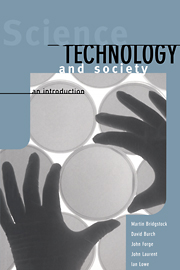Book contents
- Frontmatter
- Contents
- List of Figures
- List of Tables
- List of Contributors
- Preface
- Part One Scientific and Technological Communities
- 1 Introduction
- 2 The Scientific Community
- 3 Responsibility and the Scientist
- 4 The Rights and Wrongs of Science
- 5 Controversies Regarding Science and Technology
- Part Two Scientists and Technologists in the Wider Society
- Appendix 1 Surviving in the Information Jungle
- Appendix 2 Referencing
- Index
2 - The Scientific Community
Published online by Cambridge University Press: 04 February 2010
- Frontmatter
- Contents
- List of Figures
- List of Tables
- List of Contributors
- Preface
- Part One Scientific and Technological Communities
- 1 Introduction
- 2 The Scientific Community
- 3 Responsibility and the Scientist
- 4 The Rights and Wrongs of Science
- 5 Controversies Regarding Science and Technology
- Part Two Scientists and Technologists in the Wider Society
- Appendix 1 Surviving in the Information Jungle
- Appendix 2 Referencing
- Index
Summary
What's the go of it? What's the particular go of it?
James Clerk Maxwell, Physicist.This chapter aims to give you some idea about the world-wide scientific community and what makes it work. As the quote from Maxwell suggests, we will not be concentrating upon facts and figures, but upon the basic organisation of science, and its particular ‘go’, the way it works.
More than fifty years ago, the sociologist Robert K. Merton (1942) outlined a theory of how the scientific community works. Merton saw science as a self-regulating community of researchers, governed by a strong and distinctive ethos. This ethos involved the sharing of information, scepticism about results until evidence was produced, and a strong belief in the pursuit of truth. Merton was a shrewd observer of humanity, and was fully aware that many scientists pursue careers for their own self-interest. However, he argued, the ethos of science bound scientists to conform to the rules and expectations of science. In addition, scientists constantly scrutinised each other's work, ensuring that standards were maintained. Merton's ideal should be borne in mind as we investigate the scientific community.
The first point to make is that science is a varied activity, even within one country, as Figure 2.1 illustrates. It is based on official Australian statistics, and shows three important things about science in this country. It shows where the largest amounts of money come from to support science, where that money goes, and where the scientists are.
- Type
- Chapter
- Information
- Science, Technology and SocietyAn Introduction, pp. 15 - 39Publisher: Cambridge University PressPrint publication year: 1998
- 1
- Cited by

